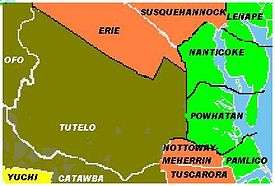Tutelo
The Tutelo (also Totero, Totteroy, Tutera; Yesan in Tutelo) were Native American people living above the Fall Line in present-day Virginia and West Virginia. They spoke a Siouan dialect of the Tutelo language thought to be similar to that of their neighbors, the Monacan and Manahoac nations. Under pressure from English settlers and Seneca Iroquois, they joined with other Virginia Siouan tribes in the late 17th century and became collectively known as the Tutelo-Saponi. By 1740, they had largely left Virginia and migrated north to seek protection from their former Iroquois opponents. They were adopted by the Cayuga tribe of New York in 1753.
 Map showing tribal lands of the Tutelo in 1565 | |
| Total population | |
|---|---|
| Extinct as an independent tribe | |
| Regions with significant populations | |
| West Virginia, Virginia (c. 1270-1701, 1714-1740), North Carolina (1701-1714), Pennsylvania (1740-1753), New York (1753-1779), Ontario (1779-ca. 1900) (descendants assimilated into Cayuga nation) | |
| Languages | |
| Siouan Tutelo language | |
| Related ethnic groups | |
| Occaneechi, Manahoac, Monacan |
Name
The English name Tutelo comes from the Algonquian variant of the name that the Iroquois used for all the Virginia Siouan tribes: Toderochrone (many variant spellings). The Tutelo autonym (name for themselves) was Yesan, Yesah or Yesang. This is also connected with the name Nahyssan, as well as earlier colonial-era spellings, such as Monahassanough (John Smith).[1]
History
The Tutelo historic homeland was said to include the area of the Big Sandy River on the West Virginia-Kentucky border, which they called the "Totteroy River." The Iroquois drove them from this region during the later Beaver Wars (c. 1670), after which the Iroquois established the Ohio Valley as their hunting ground by right of conquest.
Although previously known to the Virginia colonists by their other names, a form of Tutelo first appeared in Virginia records in 1671, when the Batts and Fallam expedition noted their visit to "Totero Town" near what is now Salem, Virginia. A few years later, the Tutelo / Nahyssan joined the Saponi to live on islands located where the Dan and Staunton rivers join to become the Roanoke River. It was just above the territory of the Occaneechi.[2] For a time, the Tutelo had a settlement in what is now Floyd County, VA on the banks of the New River. Many of the sherds collected there and the small triangular points, suggest a mid- to late 16th-century or an early 17th-century date.[3]
In 1701, they were noted as living at the headwaters of the Yadkin River in North Carolina. After 1714, collectively known as the Saponi-Tutelo, they resided at Junkatapurse around Fort Christanna in Brunswick County, Virginia, near the border with North Carolina.[4]
Over the 1730s, remnants of the Saponi, Tutelo, and Occaneechi Indians moved north to Shamokin, Pennsylvania and sought the protection of the Oneida viceroy, Shickellamy. They moved further north into present-day western New York, where they settled.
These Siouan remnants were formally adopted by the Cayuga nation of New York in 1753. Their village of "Coreorgonel" was located near present-day Ithaca, New York and Buttermilk Falls State Park. There they lived under the protection of the Cayuga until Coreorgonel, along with many other Iroquois towns, was destroyed during the American Revolutionary War by the Sullivan Expedition of 1779. It was retaliating for British-Iroquois raids against the American rebels.
The Tutelo went with the Iroquois to Canada, where the British offered land for resettlement at what became known as the Six Nations of the Grand River First Nation. They continued to live among the Cayuga and were eventually absorbed by them through intermarriage. The last known full-blooded Tutelo speaker, Nikonha or Waskiteng ("Old Mosquito") died in 1870 at the age of 105.[5] He had given extensive linguistic material to the scholar Horatio Hale, who confirmed the Tutelo language as Siouan.
Notes
- Charles Hanna, The Wilderness Trail, pp. 117-19.
- John Reed Swanton, The Indian Tribes of North America, 1906, p. 74
- Patricia Robin Woodruff, Archeological Dig into a Floyd Native American Village Site Floyd Magazine, Fall/Winter 2014, p. 42
- John Reed Swanton, The Indian Tribes of North America, 1906, p. 74
- Robert Vest, 2006, "Letters of Chief Samuel Johns to Frank G Speck".
References
- The Indian Tribes of North America, John Reed Swanton, p. 74